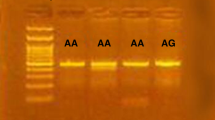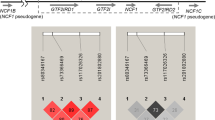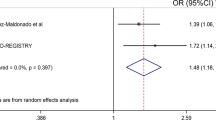Abstract
Patients with systemic juvenile idiopathic arthritis (sJIA) have a characteristic daily spiking fever and elevated levels of inflammatory cytokines. Members of the interleukin-1 (IL-1) gene family have been implicated in various inflammatory and autoimmune diseases, and treatment with the IL-1 receptor antagonist, Anakinra, shows remarkable improvement in some patients. This work describes the most comprehensive investigation to date of the involvement of the IL-1 gene family in sJIA. A two-stage case–control association study was performed to investigate the two clusters of IL-1 family genes using a tagging single nucleotide polymorphism (SNP) approach. Genotyping data of 130 sJIA patients and 151 controls from stage 1 highlighted eight SNPs in the IL1 ligand cluster region and two SNPs in the IL1 receptor cluster region as showing a significant frequency difference between the populations. These 10 SNPs were typed in an additional 105 sJIA patients and 184 controls in stage 2. Meta-analysis of the genotypes from both stages showed that three IL1 ligand cluster SNPs (rs6712572, rs2071374 and rs1688075) and one IL1 receptor cluster SNP (rs12712122) show evidence of significant association with sJIA. These results indicate that there may be aberrant control of the activity of the IL-1 family in sJIA patients causing the increased susceptibility to the disease.
This is a preview of subscription content, access via your institution
Access options
Subscribe to this journal
Receive 6 digital issues and online access to articles
$119.00 per year
only $19.83 per issue
Buy this article
- Purchase on Springer Link
- Instant access to full article PDF
Prices may be subject to local taxes which are calculated during checkout



Similar content being viewed by others
References
Petty RE . Growing pains: the ILAR classification of juvenile idiopathic arthritis. J Rheumatol 2001; 28: 927–928.
Woo P . Systemic juvenile idiopathic arthritis: diagnosis, management, and outcome. Nat Clin Pract Rheumatol 2006; 2: 28–34.
Fishman D, Faulds G, Jeffery R, Mohamed-Ali V, Yudkin JS, Humphries S et al. The effect of novel polymorphisms in the interleukin-6 (IL-6) gene on IL-6 transcription and plasma IL-6 levels, and an association with systemic-onset juvenile chronic arthritis. J Clin Invest 1998; 102: 1369–1376.
Ogilvie EM, Fife MS, Thompson SD, Twine N, Tsoras M, Moroldo M et al. The −174G allele of the interleukin-6 gene confers susceptibility to systemic arthritis in children: a multicenter study using simplex and multiplex juvenile idiopathic arthritis families. Arthritis Rheum 2003; 48: 3202–3206.
Donn RP, Shelley E, Ollier WE, Thomson W . A novel 5′-flanking region polymorphism of macrophage migration inhibitory factor is associated with systemic-onset juvenile idiopathic arthritis. Arthritis Rheum 2001; 44: 1782–1785.
de Benedetti F, Meazza C, Vivarelli M, Rossi F, Pistorio A, Lamb R et al. Functional and prognostic relevance of the −173 polymorphism of the macrophage migration inhibitory factor gene in systemic-onset juvenile idiopathic arthritis. Arthritis Rheum 2003; 48: 1398–1407.
Fife MS, Gutierrez A, Ogilvie EM, Stock CJ, Samuel JM, Thomson W et al. Novel IL10 gene family associations with systemic juvenile idiopathic arthritis. Arthritis Res Ther 2006; 8: R148.
Dinarello CA . Biologic basis for interleukin-1 in disease. Blood 1996; 87: 2095–2147.
Nicklin MJ, Barton JL, Nguyen M, FitzGerald MG, Duff GW, Kornman K . A sequence-based map of the nine genes of the human interleukin-1 cluster. Genomics 2002; 79: 718–725.
Taylor SL, Renshaw BR, Garka KE, Smith DE, Sims JE . Genomic organization of the interleukin-1 locus. Genomics 2002; 79: 726–733.
Smith DE, Renshaw BR, Ketchem RR, Kubin M, Garka KE, Sims JE . Four new members expand the interleukin-1 superfamily. J Biol Chem 2000; 275: 1169–1175.
Kumar S, McDonnell PC, Lehr R, Tierney L, Tzimas MN, Griswold DE et al. Identification and initial characterization of four novel members of the interleukin-1 family. J Biol Chem 2000; 275: 10308–10314.
Lin H, Ho AS, Haley-Vicente D, Zhang J, Bernal-Fussell J, Pace AM et al. Cloning and characterization of IL-1HY2, a novel interleukin-1 family member. J Biol Chem 2001; 276: 20597–20602.
Debets R, Timans JC, Homey B, Zurawski S, Sana TR, Lo S et al. Two novel IL-1 family members, IL-1 delta and IL-1 epsilon, function as an antagonist and agonist of NF-kappa B activation through the orphan IL-1 receptor-related protein 2. J Immunol 2001; 167: 1440–1446.
Towne JE, Garka KE, Renshaw BR, Virca GD, Sims JE . Interleukin (IL)-1F6, IL-1F8, and IL-1F9 signal through IL-1Rrp2 and IL-1RAcP to activate the pathway leading to NF-kappaB and MAPKs. J Biol Chem 2004; 279: 13677–13688.
Bufler P, Azam T, Gamboni-Robertson F, Reznikov LL, Kumar S, Dinarello CA et al. A complex of the IL-1 homologue IL-1F7b and IL-18-binding protein reduces IL-18 activity. Proc Natl Acad Sci USA 2002; 99: 13723–13728.
Dale M, Nicklin MJ . Interleukin-1 receptor cluster: gene organization of IL1R2, IL1R1, IL1RL2 (IL-1Rrp2), IL1RL1 (T1/ST2), and IL18R1 (IL-1Rrp) on human chromosome 2q. Genomics 1999; 57: 177–179.
Stylianou E, O'Neill LA, Rawlinson L, Edbrooke MR, Woo P, Saklatvala J . Interleukin 1 induces NF-kappa B through its type I but not its type II receptor in lymphocytes. J Biol Chem 1992; 267: 15836–15841.
Subramaniam S, Stansberg C, Cunningham C . The interleukin 1 receptor family. Dev Comp Immunol 2004; 28: 415–428.
Prieur AM, Roux-Lombard P, Dayer JM . Dynamics of fever and the cytokine network in systemic juvenile arthritis. Rev Rhum Engl Ed 1996; 63: 163–170.
Muller K, Herner EB, Stagg A, Bendtzen K, Woo P . Inflammatory cytokines and cytokine antagonists in whole blood cultures of patients with systemic juvenile chronic arthritis. Br J Rheumatol 1998; 37: 562–569.
Pascual V, Allantaz F, Arce E, Punaro M, Banchereau J . Role of interleukin-1 (IL-1) in the pathogenesis of systemic onset juvenile idiopathic arthritis and clinical response to IL-1 blockade. J Exp Med 2005; 201: 1479–1486.
Lequerre T, Quartier P, Rosellini D, Alaoui F, De Bandt M, Mejjad O et al. Interleukin-1 receptor antagonist (anakinra) treatment in patients with systemic-onset juvenile idiopathic arthritis or adult onset Still's disease. Preliminary experience in France. Ann Rheum Dis 2008; 67: 302–308.
Lovell D, Giannini E, Kinura Y, Li S, Hashkes P, Reiff A et al. Preliminary evidence for bioactivity of IL-1 TRAP (Rilonacept), a long acting IL-1 inhibitor, in systemic juvenile idiopathic arthritis. Ann Rheum Dis 2006; 65 (Suppl II): 693.Ref Type: Abstract.
Meulenbelt I, Seymour AB, Nieuwland M, Huizinga TW, van Duijn CM, Slagboom PE . Association of the interleukin-1 gene cluster with radiographic signs of osteoarthritis of the hip. Arthritis Rheum 2004; 50: 1179–1186.
Buchs N, di Giovine FS, Silvestri T, Vannier E, Duff GW, Miossec P . IL-1B and IL-1Ra gene polymorphisms and disease severity in rheumatoid arthritis: interaction with their plasma levels. Genes Immun 2001; 2: 222–228.
Jouvenne P, Chaudhary A, Buchs N, Giovine FS, Duff GW, Miossec P . Possible genetic association between interleukin-1alpha gene polymorphism and the severity of chronic polyarthritis. Eur Cytokine Netw 1999; 10: 33–36.
Timms AE, Crane AM, Sims AM, Cordell HJ, Bradbury LA, Abbott A et al. The interleukin 1 gene cluster contains a major susceptibility locus for ankylosing spondylitis. Am J Hum Genet 2004; 75: 587–595.
van der PM, Crusius JB, Garcia-Gonzalez MA, Baudoin P, Kostense PJ, Alizadeh BZ et al. Interleukin-1beta and interleukin-1 receptor antagonist gene polymorphisms in ankylosing spondylitis. Rheumatology (Oxford) 2002; 41: 1419–1423.
Tazi-Ahnini R, Cox A, McDonagh AJ, Nicklin MJ, di Giovine FS, Timms JM et al. Genetic analysis of the interleukin-1 receptor antagonist and its homologue IL-1L1 in alopecia areata: strong severity association and possible gene interaction. Eur J Immunogenet 2002; 29: 25–30.
Kinane DF, Hart TC . Genes and gene polymorphisms associated with periodontal disease. Crit Rev Oral Biol Med 2003; 14: 430–449.
Bergholdt R, Larsen ZM, Andersen NA, Johannesen J, Kristiansen OP, Mandrup-Poulsen T et al. Characterization of new polymorphisms in the 5′ UTR of the human interleukin-1 receptor type 1 (IL1R1) gene: linkage to type 1 diabetes and correlation to IL-1RI plasma level. Genes Immun 2000; 1: 495–500.
McDowell TL, Symons JA, Ploski R, Forre O, Duff GW . A genetic association between juvenile rheumatoid arthritis and a novel interleukin-1 alpha polymorphism. Arthritis Rheum 1995; 38: 221–228.
Donn RP, Farhan AJ, Barrett JH, Thomson W, Worthington J, Ollier WE . Absence of association between interleukin 1 alpha and oligoarticular juvenile chronic arthritis in UK patients. Rheumatology (Oxford) 1999; 38: 171–175.
Vencovsky J, Jarosova K, Ruzickova S, Nemcova D, Niederlova J, Ozen S et al. Higher frequency of allele 2 of the interleukin-1 receptor antagonist gene in patients with juvenile idiopathic arthritis. Arthritis Rheum 2001; 44: 2387–2391.
Sugiura T, Maeno N, Kawaguchi Y, Takei S, Imanaka H, Kawano Y et al. A promoter haplotype of the interleukin-18 gene is associated with juvenile idiopathic arthritis in the Japanese population. Arthritis Res Ther 2006; 8: R60.
Niki Y, Yamada H, Kikuchi T, Toyama Y, Matsumoto H, Fujikawa K et al. Membrane-associated IL-1 contributes to chronic synovitis and cartilage destruction in human IL-1 alpha transgenic mice. J Immunol 2004; 172: 577–584.
Graudal NA, Svenson M, Tarp U, Garred P, Jurik AG, Bendtzen K . Autoantibodies against interleukin 1alpha in rheumatoid arthritis: association with long term radiographic outcome. Ann Rheum Dis 2002; 61: 598–602.
Smith DE, Hanna R, Della F, Moore H, Chen H, Farese AM et al. The soluble form of IL-1 receptor accessory protein enhances the ability of soluble type II IL-1 receptor to inhibit IL-1 action. Immunity 2003; 18: 87–96.
Ogilvie EM, Fife MS, Thompson SD, Twine N, Tsoras M, Moroldo M et al. The −174G allele of the interleukin-6 gene confers susceptibility to systemic arthritis in children: a multicenter study using simplex and multiplex juvenile idiopathic arthritis families. Arthritis Rheum 2003; 48: 3202–3206.
Wellcome Trust Case Control Consortium. Genome-wide association study of 14,000 cases of seven common diseases and 3,000 shared controls. Nature 2007; 447: 661–678.
Marchini J, Howie B, Myers S, McVean G, Donnelly P . A new multipoint method for genome-wide association studies by imputation of genotypes. Nat Genet 2007; 39: 906–913.
Lewis CM . Genetic association studies: design, analysis and interpretation. Brief Bioinform 2002; 3: 146–153.
The International HapMap Consortium. The International HapMap Project. Nature 2003; 426: 789–796.
Barrett JC, Fry B, Maller J, Daly MJ . Haploview: analysis and visualization of LD and haplotype maps. Bioinformatics 2005; 21: 263–265.
de Bakker PI, Yelensky R, Pe'er I, Gabriel SB, Daly MJ, Altshuler D . Efficiency and power in genetic association studies. Nat Genet 2005; 37: 1217–1223.
Satagopan JM, Venkatraman ES, Begg CB . Two-stage designs for gene-disease association studies with sample size constraints. Biometrics 2004; 60: 589–597.
Skol AD, Scott LJ, Abecasis GR, Boehnke M . Joint analysis is more efficient than replication-based analysis for two-stage genome-wide association studies. Nat Genet 2006; 38: 209–213.
Dudbridge F . Pedigree disequilibrium tests for multilocus haplotypes. Genet Epidemiol 2003; 25: 115–121.
Cordell HJ, Clayton DG . A unified stepwise regression procedure for evaluating the relative effects of polymorphisms within a gene using case/control or family data: application to HLA in type 1 diabetes. Am J Hum Genet 2002; 70: 124–141.
Purcell S, Neale B, Todd-Brown K, Thomas L, Ferreira MA, Bender D et al. PLINK: a tool set for whole-genome association and population-based linkage analyses. Am J Hum Genet 2007; 81: 559–575.
Acknowledgements
We thank BSPAR study group members: Dr M Abinun, Dr M Becker, Dr A Bell, Professor A Craft, Dr E Crawley, Dr J David, Dr H Foster, Dr J Gardener-Medwin, Dr J Griffin, Dr A Hall, Dr M Hall, Dr A Herrick, Dr P Hollingworth, Dr L Holt, Dr S Jones, Dr G Pountain, Dr C Ryder, Professor T Southwood, Dr I Stewart, Dr H Venning, Dr L Wedderburn, Professor P Woo and Dr S Wyatt; Dr AM Prieur and the French association Kourir; Dr J Packham, for the contribution of patient DNA and Dr Ele Zeggini for assistance with analysis. This work was funded by the Nuffield Foundation Oliver Bird Rheumatism Program and the Arthritis Research Campaign (arc).
Author information
Authors and Affiliations
Corresponding author
Rights and permissions
About this article
Cite this article
Stock, C., Ogilvie, E., Samuel, J. et al. Comprehensive association study of genetic variants in the IL-1 gene family in systemic juvenile idiopathic arthritis. Genes Immun 9, 349–357 (2008). https://doi.org/10.1038/gene.2008.24
Received:
Revised:
Accepted:
Published:
Issue Date:
DOI: https://doi.org/10.1038/gene.2008.24
Keywords
This article is cited by
-
Morbus Still im Kindes- und Erwachsenenalter
Zeitschrift für Rheumatologie (2017)
-
Morbus Still im Kindes- und Erwachsenenalter
Der Hautarzt (2017)
-
Juvenile arthritis caused by a novel FAMIN (LACC1) mutation in two children with systemic and extended oligoarticular course
Pediatric Rheumatology (2016)
-
Mitochondrial and oxidative stress genes are differentially expressed in neutrophils of sJIA patients treated with tocilizumab: a pilot microarray study
Pediatric Rheumatology (2016)
-
Caspase-1 als Regulator der Autoinflammation bei rheumatischen Erkrankungen
Zeitschrift für Rheumatologie (2016)



